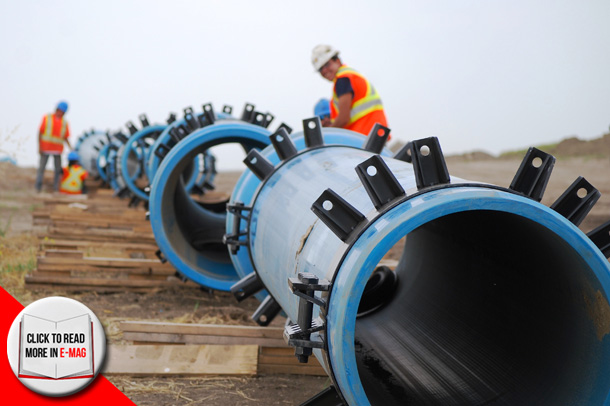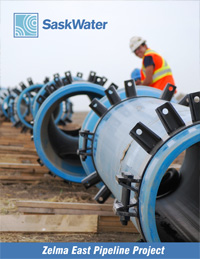By Cheryl Long
The largest construction project ever undertaken by SaskWater, Saskatchewan’s commercial Crown water utility, is well on its way to completion, poised to supply seven million cubic metres of water annually to a new potash mine under development near Jansen, SK.
The massive undertaking will carry water from Zelma Reservoir along the Saskatoon Southeast Water Supply System (SSEWSS) to the BHP Billiton mine site, which is anticipated to produce up to 10 million tons of potash per year. It’s also expected that the 94-kilometre pipeline will enhance water availability to communities along the route.
Tim Jansen is Manager of Major Projects for SaskWater and is leading the $141-million project, which began as an idea back in 2008 when the utility company was approached by BHP Billiton, an Australia-based global resources organization. The company was looking for a water supplier for their proposed potash mine, located approximately 140 kilometres east of Saskatoon. SaskWater provides professional water and wastewater services to 63 communities, eight rural municipalities, 83 rural pipeline groups, 16 industrial and approximately 236 commercial and end user customers. But overseeing a project of this magnitude was going to take the organization to a new level.
“We currently are worth somewhere close to $300 million with our assets so this is a significant increase to our asset makeup,” Jansen explained. “We are called a small utility. It’s a significant undertaking to perform this activity.”
Potash mine could be taking water by late 2015
The project began in earnest in 2012 when SaskWater began putting out tenders for pipe supply, ensuring that materials would be available and work could begin as soon as contractors were hired in early 2013. The target goal was to have BHP Billiton begin taking water by the end of 2015, Jansen said. SaskWater proceeded to hire a team of consultants and contractors from several provinces and then set up various processes that included an integrated project management system with a financial tracking component, safety and quality assurance programs, and a bio management system, all intended to ensure the success of the expansive project.
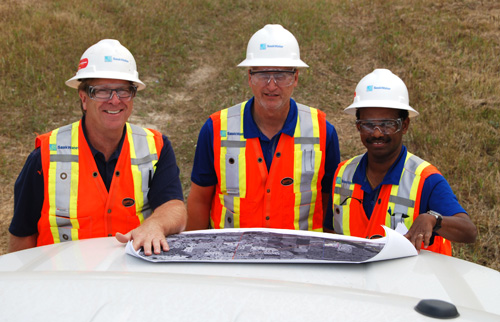
Gary Sears, Senior Project Supervisor, Major Projects; Tim Jansen, Manager, Major Projects; and Sumith Kahanda, Senior Project Engineer on the Zelma East Project for SaskWater.
One of the project’s challenges, Jansen said, revolved around finding a reservoir that could handle the volume of water needed to supply the mine. One concern was the issue of overwintering. It was determined that the Zelma Reservoir, which is part of a 137-kilometre canal system, could provide enough water to meet the mine’s needs. But because freezing temperatures force the canal to shut down during the winter, the reservoir also needed enough capacity to store at least half of the required volume of water. Zelma also met that requirement, and plans got underway to upgrade the dam and dike enclosures, improve several kilometres of the canals feeding the reservoir and replace an aging pump station.
Another challenge was the installation of a one-kilometre intake pipe in the reservoir, which had to be designed in a way that wouldn’t harm the fish population and would take in equal amounts of water along its length. The nature of the area and the waterway meant that SaskWater had to deal with the Ministry of Fisheries and Oceans, addressing all concerns from an environmental perspective. Areas where water fowl were nesting or staging had to be avoided and there were also restrictions surrounding the area’s rare and endangered vegetation.
“You’re always looking at how to best deal with a project to come up with the least cost, most effective long-term solution without impacting the environment,” Jansen said. “We’ve always taken the approach if you do sufficient work in preparedness, it’s going to help you out in your construction.”
Integrated project management key to success
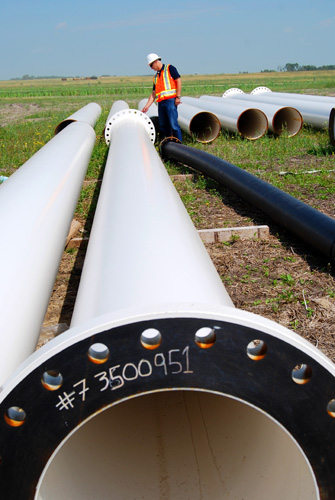 Part of that preparedness can be credited to the integrated project management process, which has been key to keeping the project on track, Jansen said. It includes a share file management system that gives BHP Billiton up-to-date access to ongoing work and financials, and allows SaskWater to keep on top of the various work fronts. Early identification of any problem areas, and then addressing those issues and getting the project back on track, has been key to its success.
Part of that preparedness can be credited to the integrated project management process, which has been key to keeping the project on track, Jansen said. It includes a share file management system that gives BHP Billiton up-to-date access to ongoing work and financials, and allows SaskWater to keep on top of the various work fronts. Early identification of any problem areas, and then addressing those issues and getting the project back on track, has been key to its success.
“It’s the largest project I’ve ever worked on. I’m kind of proud to be involved with it,” Jansen said. “It’s a highlight … when you’ve implemented and worked with various projects all through your career but never taken on one of this magnitude and the challenges that go along with it. Now you’re implementing all the tools you’ve developed over your career.
“To be part of this is something you dream of and I get the opportunity to live the dream.”
Safety protocols crucial for all workers
At any one time, SaskWater has had 200 people working on site and that’s why safety protocols have been paramount. Each contractor has a safety plan in place that includes an orientation process for everyone working on the various sites. They’re made aware of the activities they’ll be undertaking, along with the required tools and safety equipment. Daily meetings ensure that all workers are aware of the safety issues and requirements for that day’s operations. “All the safe work practices are documented and everyone is aware of the need of performing their work in the safest fashion,” Jansen explained. Steps have been taken to ensure that everyone returns home safely at the end of the day, from setting up spotters on top of trenches to providing confined space training to employees. If incidents do occur, there’s a reporting mechanism in place that tracks the situation and develops a process to prevent it from happening again.
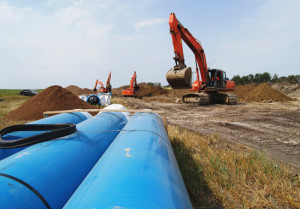 “Communication is very integral in this project,” Jansen said. “Clients need information on a timely basis. Team players have to be informed of anything that needs to be addressed. We’re getting into winter and we have to make sure things are rolling on and not impacting other areas.”
“Communication is very integral in this project,” Jansen said. “Clients need information on a timely basis. Team players have to be informed of anything that needs to be addressed. We’re getting into winter and we have to make sure things are rolling on and not impacting other areas.”
SaskWater has a solid service record with its clients, built on a level of dedication and commitment to excellence that permeates all aspects of the Zelma East pipeline project. The organization prides itself on delivering quality results with little disruption to service while meeting the standards that clients expect.
“I think that’s why the likes of the BHP Billitons of the world are coming to us, because they see the services we’ve provided to the other entities … and we believe they like that kind of service delivery.”
Visit www.saskwater.com to learn more about the company and its projects.

